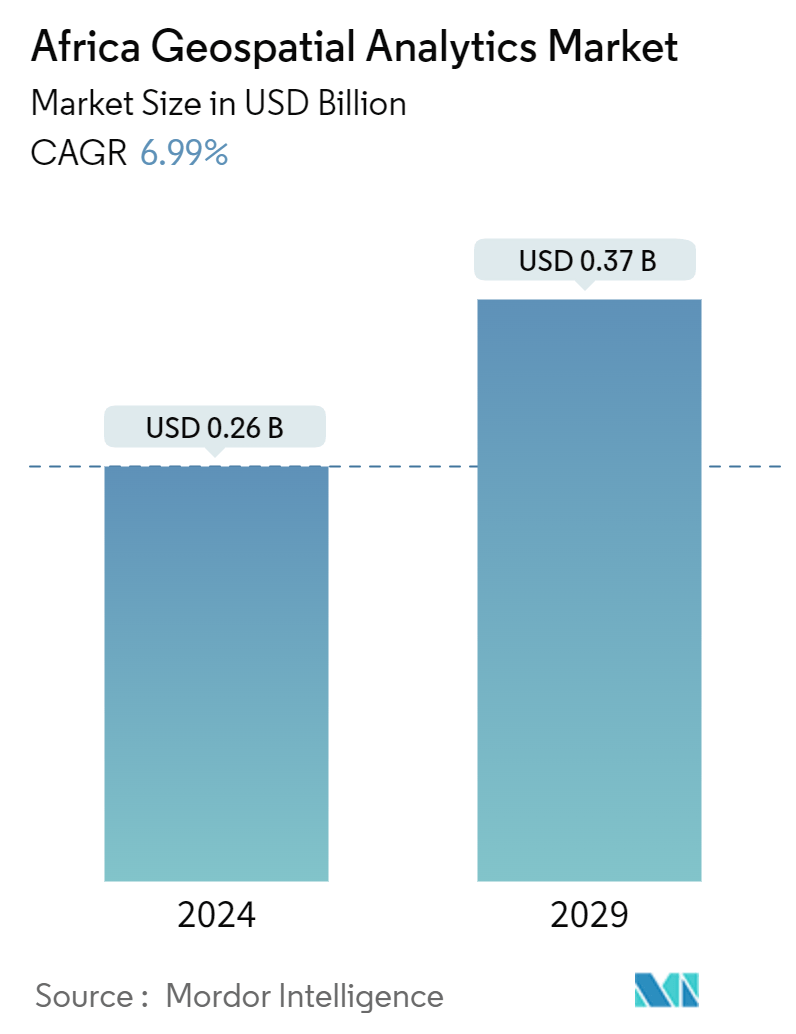Market Size of Africa Geospatial Analytics Industry

| Study Period | 2019 - 2029 |
| Base Year For Estimation | 2023 |
| Market Size (2024) | USD 0.26 Billion |
| Market Size (2029) | USD 0.37 Billion |
| CAGR (2024 - 2029) | 6.99 % |
| Market Concentration | Medium |
Major Players
*Disclaimer: Major Players sorted in no particular order |
Africa Geospatial Analytics Market Analysis
The Africa Geospatial Analytics Market size is estimated at USD 0.26 billion in 2024, and is expected to reach USD 0.37 billion by 2029, growing at a CAGR of 6.99% during the forecast period (2024-2029).
- The increased usage of modern technologies like remote sensing, GIS (Geographic Information System), and GPS (Global Positioning System) across numerous industrial verticals has led to substantial expansion in the Africa geospatial analytics market in recent years. In order to gain knowledge and make informed decisions, geospatial analytics refers to gathering, analyzing, and interpreting geospatial data.
- Geospatial analytics is increasingly valued by governments in many African nations for resource management and sustainable development. For instance, the African Union introduced the African Space Policy and Strategy, which aims to leverage space science and technology for socioeconomic development, including applications for geospatial analytics.
- Geospatial analytics is widely employed for precision farming, crop monitoring, land management, and yield optimization because agriculture is essential to Africa's economy. Businesses use advanced analytics and satellite images to give farmers real-time data on crop health, soil moisture, and meteorological conditions, empowering them to make data-driven decisions.
- In African cities, population growth and rapid urbanization have heightened the need for adequate infrastructure management and urban planning. For instance, the city of Nairobi in Kenya has implemented a geospatial analytics platform to track traffic jams, manage transportation routes, and enhance urban mobility in general.
Africa Geospatial Analytics Industry Segmentation
Geospatial analytics is acquiring, manipulating, and displaying imagery and data from the geographic information system (GIS), such as satellite photos and GPS data. The specific identifiers of a street address and a zip code are used in geospatial data analytics. They are used to create geographic models and data visualizations for more accurate trends modeling and forecasting.
The Africa Geospatial Analytics Market is segmented by type (surface analysis, network analysis, geovisualization), by end user vertical (agriculture, utility and communication, defence and intelligence, government, mining and natural resources, automotive and transportation, healthcare, real estate, and construction). The market sizes and forecasts are provided regarding value (USD) for all the above segments.
| By Type | |
| Surface Analysis | |
| Network Analysis | |
| Geo-visualization |
| By End-user Vertical | |
| Agriculture | |
| Utility and Communication | |
| Defense and Intelligence | |
| Government | |
| Mining and Natural Resources | |
| Automotive and Transportation | |
| Healthcare | |
| Real Estate and Construction | |
| Other End-user Verticals |
Africa Geospatial Analytics Market Size Summary
The Africa Geospatial Analytics Market is experiencing significant growth, driven by the increasing adoption of advanced technologies such as remote sensing, GIS, and GPS across various industries. This market expansion is fueled by the growing need for data-driven decision-making in sectors like agriculture, urban planning, and resource management. Governments in Africa are recognizing the value of geospatial analytics for sustainable development, as evidenced by initiatives like the African Union's Space Policy. The agriculture sector, crucial to Africa's economy, benefits from precision farming and crop monitoring, enabling farmers to optimize yields through real-time data on environmental conditions. Urbanization and population growth in African cities have heightened the demand for effective infrastructure management, with cities like Nairobi leveraging geospatial analytics to improve urban mobility and traffic management.
The availability of spatial data has been enhanced by advancements in satellite technology and remote sensing, making geospatial analytics more accessible to businesses without significant upfront costs. The rise of mobile applications and location-based services has further propelled market demand, with companies like Uber utilizing geospatial analytics to optimize operations. The commercialization of spatial data is transforming agriculture and natural resource management, offering precision agricultural solutions that improve efficiency and productivity. In the insurance sector, geospatial analytics is used to assess risks from natural disasters, aiding in premium calculation and claim settlement. African governments are also using geospatial analytics to enhance urban sustainability and resilience, with cities like Cape Town and Accra implementing strategies to manage water resources and disaster response. The market is semi-consolidated, with key players like Autodesk and Bentley Systems driving innovation through new products and strategic partnerships.
Africa Geospatial Analytics Market Size - Table of Contents
-
1. MARKET INSIGHTS
-
1.1 Market Overview
-
1.2 Industry Attractiveness - Porter's Five Forces Analysis
-
1.2.1 Bargaining Power of Buyers
-
1.2.2 Bargaining Power of Suppliers
-
1.2.3 Threat of New Entrants
-
1.2.4 Threat of Substitutes
-
1.2.5 Intensity of Competitive Rivalry
-
-
1.3 Industry Value Chain Analysis
-
1.4 Assessment of the Impact of COVID-19 on the Market
-
-
2. MARKET SEGMENTATION
-
2.1 By Type
-
2.1.1 Surface Analysis
-
2.1.2 Network Analysis
-
2.1.3 Geo-visualization
-
-
2.2 By End-user Vertical
-
2.2.1 Agriculture
-
2.2.2 Utility and Communication
-
2.2.3 Defense and Intelligence
-
2.2.4 Government
-
2.2.5 Mining and Natural Resources
-
2.2.6 Automotive and Transportation
-
2.2.7 Healthcare
-
2.2.8 Real Estate and Construction
-
2.2.9 Other End-user Verticals
-
-
Africa Geospatial Analytics Market Size FAQs
How big is the Africa Geospatial Analytics Market?
The Africa Geospatial Analytics Market size is expected to reach USD 0.26 billion in 2024 and grow at a CAGR of 6.99% to reach USD 0.37 billion by 2029.
What is the current Africa Geospatial Analytics Market size?
In 2024, the Africa Geospatial Analytics Market size is expected to reach USD 0.26 billion.

